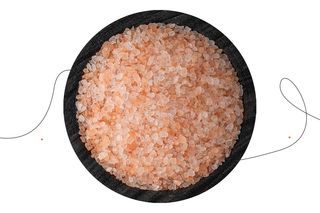
Untrending: Himalayan Salt Is Just Regular Salt That’s Pink
There’s no proof pink Himalayan salt — which isn’t even from the Himalayas — offers any unique health or beauty benefits.

In Untrending, we side-eye the latest fads so we know what we’re getting ourselves into — and what (if anything) we’re getting out of them.
Regular salt? Plain, white, alright. Pink Himalayan salt? A delightfully rosy color, stuffed with up to 84 minerals and elements, not to mention the ions that detoxify both skin and the air around you, according to celebrities and wellness gurus. Oprah, Kourtney Kardashian, and Gwyneth Paltrow swear by the pink salt for its health and beauty benefits.
But — there’s no convincing evidence that proves pink Himalayan salt’s health or beauty benefits beyond that of any edible salt.
In fact, raw pink Himalayan salt contains far less iodine than iodized salt you’d buy at the store. As for the 84 different minerals and elements, they include potassium, calcium, molybdenum, magnesium, iron, and of course, sodium — but they exist in trace amounts only that are too tiny to aid the body’s nutrition requirements in any notable way. For example: there’s about 3 mg of potassium in 1 gram of pink Himalayan salt. A human would need to consume an unrealistic amount of this salt to obtain their daily potassium intake (around 3000mg). A balanced diet can accomplish the same with far more ease and health benefits.
Plus, some of the trace elements present in pink Himalayan salt are harmful, like arsenic and uranium. While, like the above useful elements, the harmful ones exist in such small amounts that they can’t do any real damage like poisoning or kidney damage, respectively.
Related on The Swaddle:
The ‘Bliss Point’ Is How Food Companies Ensure You Can’t Have Just One French Fry
Still, advocates of pink Himalayan salt say that breathing in salty air in pink salt caves (known as halotherapy) can help treat breathing issues like coughing, wheezing, and Chronic Obstructive Pulmonary Disease (CoPD). Scientific research around this shows marginal benefits, and most scientists say more rigorous research is necessary to confirm them, which means there’s no credible way to say pink Himalayan salt can help manage breathing problems yet. Some prefer to use pink Himalayan salt lamps, which are bulbs placed inside large chunks of this salt. Salt lamps are supposed to be natural negative ionizers that help with mood and air purification. However, there’s no scientific evidence of pink Himalayan salt’s ability to either purify air or elevate mood.
Consuming pink Himalayan salt is supposed to remedy sleep troubles and regulate the body’s pH, blood sugar, and even libido. With respect to sleep, some research suggests that consuming less sodium leads to trouble sleeping, but adding any salt, not just pink Himalayan salt, to your diet can fix this. In fact, there’s less sodium in pink Himalayan salts than regular salts, so pink salt might be less effective than other salts in helping one sleep better.
Blood sugar regulation is primarily controlled by carbohydrate levels and insulin levels and activity, while libido is controlled by hormones and mental health factors. Salts of any color do not have any radical effect on either. As for body pH, the lungs and the kidneys maintain the body’s acid-base homeostasis, which doesn’t vary unless the body is dealing with a critical illness, in which case a doctor can recommend the best course of action. Again — salt of any kind has no role in this.
Apart from health claims, Himalayan salts are also touted as quality beauty and wellness products — primarily as soothing bath salts and exfoliants. Mineral bath salts in general can help provide a soothing effect while bathing for individuals experiencing eczema flares. Apart from medicinal relief, baths can also deploy a placebo effect that helps relax people, both with and without bath salts. As for exfoliation — salt, in general, is a physical exfoliant, but is best used on the body, as physical exfoliants cause micro-tears on the face’s sensitive skin. Both the soothing effect and exfoliation can be accomplished with regular salt, too, which makes pink Himalayan salt a novelty more than a substance with unique benefits.
The final word? Pink Himalayan salt doesn’t come from the Himalayas, but from salt mines located south of the mountains, between Islamabad and Lahore in Pakistan. The only unique thing about pink Himalayan salt is that it’s pink — a color it derives from the iron oxides present in it. And in the end, that lovely hue is the only benefit we’re paying extra for.
Aditi Murti is a culture writer at The Swaddle. Previously, she worked as a freelance journalist focused on gender and cities. Find her on social media @aditimurti.
Related


Why Do Some People Get Headaches in the Morning?
